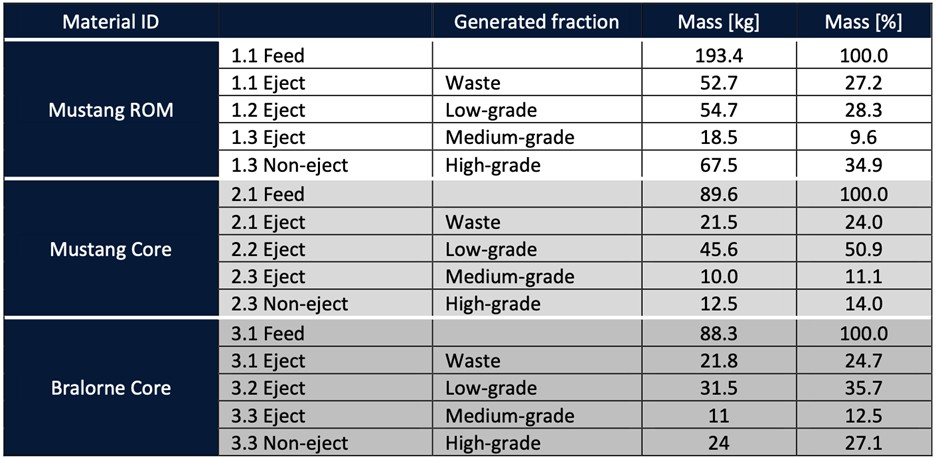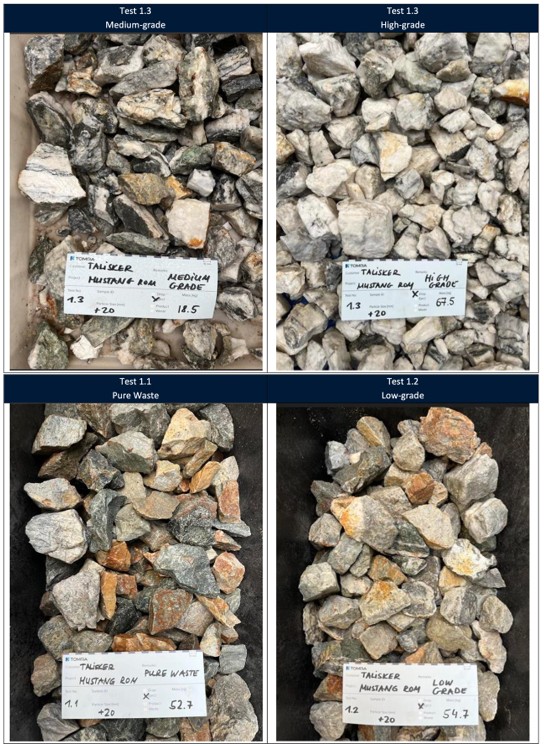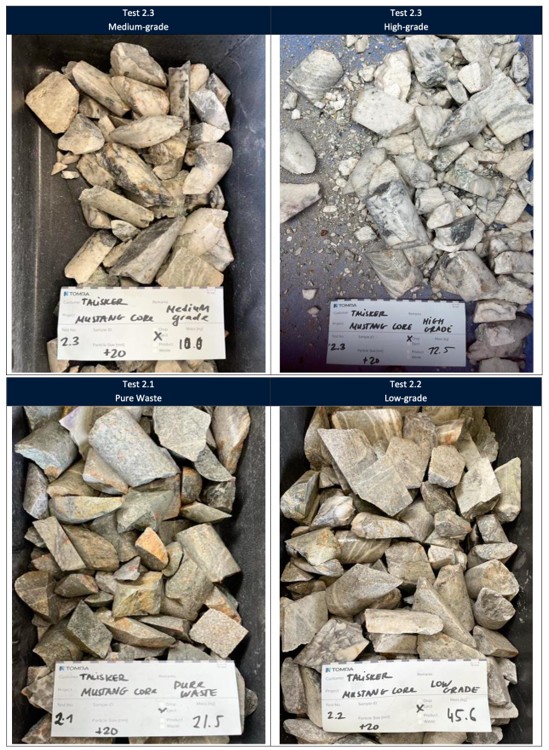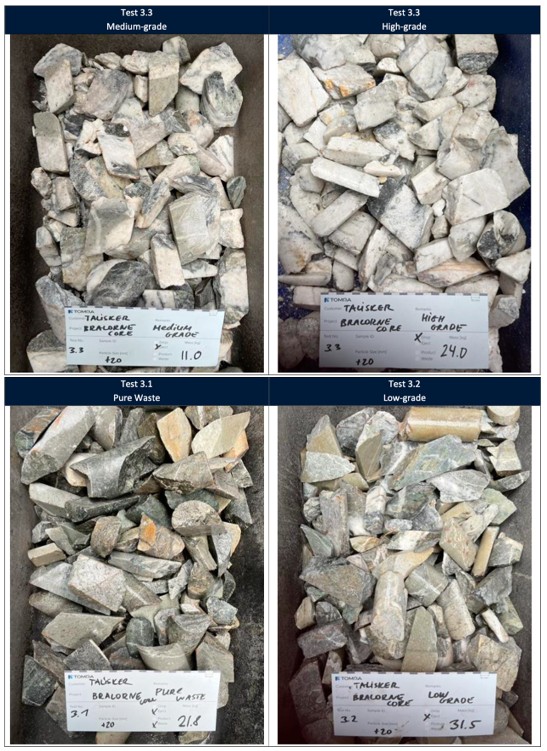Talisker Receives Preliminary Results from the Second Phase of Ore Sorting Studies for the Bralorne Gold Project
Talisker Resources (OTCQX:TSKFF) has announced promising preliminary results from the second phase of laser-based ore sorting studies at its Bralorne Gold Project in British Columbia. The testing, conducted at Tomra's test centre in Germany, processed 371.3 kilograms of material using multi-channel laser sorting technologies.
The first phase demonstrated impressive results, increasing average feed grade from 14.4 g/t gold to 27.8 g/t gold, with gold recoveries between 95% and 99% while rejecting 35-55% of total rock mass as waste. The second phase utilized a cascading procedure with three sequential sorting steps, each with increasing waste sensitivity, allowing for simulation of potential production outcomes.
Talisker Resources (OTCQX:TSKFF) ha diffuso risultati preliminari incoraggianti dalla seconda fase degli studi di selezione del minerale basati su laser presso il suo Bralorne Gold Project in British Columbia. I test, eseguiti presso il centro prove di Tomra in Germania, hanno trattato 371,3 chilogrammi di materiale impiegando tecnologie di selezione laser multicanale.
La prima fase aveva già mostrato ottimi risultati, aumentando la tenore medio di alimentazione da 14,4 g/t d'oro a 27,8 g/t d'oro, con recuperi d'oro compresi tra il 95% e il 99% e scartando il 35-55% della massa rocciosa come rifiuto. La seconda fase ha adottato una procedura a cascata con tre passaggi di selezione sequenziali, ciascuno con crescente sensibilità allo scarto, permettendo di simulare possibili esiti di produzione.
Talisker Resources (OTCQX:TSKFF) ha anunciado resultados preliminares prometedores de la segunda fase de estudios de clasificación de mineral por láser en su Bralorne Gold Project en Columbia Británica. Las pruebas, realizadas en el centro de ensayos de Tomra en Alemania, procesaron 371,3 kilogramos de material utilizando tecnologías de clasificación láser multicanal.
La primera fase ya había mostrado resultados destacados, elevando la ley media de alimentación de 14,4 g/t de oro a 27,8 g/t de oro, con recuperaciones de oro entre el 95% y el 99%, rechazando entre el 35 y el 55% de la masa rocosa como desperdicio. La segunda fase empleó un procedimiento en cascada con tres pasos secuenciales de clasificación, cada uno con mayor sensibilidad al rechazo, permitiendo simular posibles resultados de producción.
Talisker Resources (OTCQX:TSKFF)는 브리티시컬럼비아에 있는 Bralorne Gold Project에서 레이저 기반 광석 선별 연구 2단계의 유망한 예비 결과를 발표했습니다. 독일 Tomra 시험센터에서 실시된 테스트는 멀티채널 레이저 선별 기술을 사용해 371.3 킬로그램의 시료를 처리했습니다.
1단계에서는 평균 투입 품위가 14.4 g/t 금에서 27.8 g/t 금으로 크게 향상되었고, 금 회수율은 95%~99% 범위였으며 전체 암석의 35~55%를 폐석으로 배제했습니다. 2단계는 폐기물 민감도를 점차 높이는 세 번의 연속 선별 단계로 구성된 캐스케이드 절차를 사용해 잠재적 생산 결과를 시뮬레이션할 수 있었습니다.
Talisker Resources (OTCQX:TSKFF) a annoncé des résultats préliminaires prometteurs de la deuxième phase d'études de tri de minerai par laser sur son Bralorne Gold Project en Colombie-Britannique. Les essais, réalisés au centre d'essais de Tomra en Allemagne, ont traité 371,3 kilogrammes de matériau en utilisant des technologies de tri laser multicanaux.
La première phase avait déjà donné des résultats remarquables, augmentant la teneur moyenne d'alimentation de 14,4 g/t d'or à 27,8 g/t d'or, avec des récupérations aurifères comprises entre 95% et 99%, tout en rejetant 35–55% de la masse rocheuse comme déchet. La deuxième phase a utilisé une procédure en cascade composée de trois étapes de tri successives, chacune avec une sensibilité accrue au rejet, permettant de simuler des résultats de production potentiels.
Talisker Resources (OTCQX:TSKFF) hat vielversprechende vorläufige Ergebnisse der zweiten Phase laserbasierter Erzsortier-Studien auf seinem Bralorne Gold Project in British Columbia bekannt gegeben. Die Tests, durchgeführt im Tomra-Prüfzentrum in Deutschland, verarbeiteten 371,3 Kilogramm Material unter Einsatz multikanaliger Laser-Sortiertechnologien.
Die erste Phase hatte bereits beeindruckende Resultate gezeigt: der durchschnittliche Zuführgehalt stieg von 14,4 g/t Gold auf 27,8 g/t Gold, mit Goldrückgewinnungsraten zwischen 95% und 99%, während 35–55% der Gesteinsmasse als Abfall verworfen wurden. In der zweiten Phase wurde ein Kaskadenverfahren mit drei aufeinanderfolgenden Sortierschritten angewandt, jeweils mit steigender Abfallempfindlichkeit, was die Simulation möglicher Produktionsergebnisse erlaubte.
- First phase achieved exceptional gold recoveries of 95-99%
- Successfully increased feed grade from 14.4 g/t to 27.8 g/t gold
- Efficient waste rejection of 35-55% of total rock mass
- Technology demonstrates strong compatibility with Bralorne vein material
- Full assay results from second phase testing still pending
- Additional design, permitting and construction phases required before implementation
TORONTO, Sept. 03, 2025 (GLOBE NEWSWIRE) -- Talisker Resources Ltd. (“Talisker” or the “Company”) (TSX: TSK, OTCQX: TSKFF) is pleased to announce preliminary results from the second stage of laser-based ore-sorting of material from the Company’s Bralorne Gold Project located in British Columbia (“Bralorne”).
The first phase of ore sorting at Bralorne (see press release of February 26, 2025) resulted in an increase of the average feed grade from 14.4 grams per tonne gold to a final sorted product grade of 27.8 grams per tonne gold. The preliminary results also rejected between
The second stage of testing was a run of mine test-work program using full-scale equipment to allow for a direct comparison to full-scale production projections. A total of 371.3 kilograms of material was processed at Tomra’s test centre in Wedel, Germany using multi-channel laser sorting technologies, specifically the PRO Secondary LASER Dual Device. Tomra’s laser sorting uses a multi-channel laser system to scan the surface of rock particles. The degrees of diffusion (scattering effects) on the surface of the rocks varies with distinct types of minerals, as well as with their crystallinity and colour. The different spot sizes of the diffusion measured are analysed using Tomra’s image processing software providing for the detection of small variances in surface patterns, even when those patterns are identical in colour. The different selected colour classes (coloured pixels) are then assessed as a percentage of the single rock area with this percentage used as a parameter to determine and to set the sorting cut-off grade.
Terry Harbort, CEO of Talisker stated, “We are impressed with these results using our run of mine material and full-scale equipment. We can clearly see the ability of the sorter to concentrate mineralized quartz vein material into the high-grade and medium-grade fractions while separating waste material into the pure waste and low-grade fractions (see figures 1 – 3). As we await the corresponding assay results for each fraction, we will be fast-tracking to the design, permitting and construction phases.”
The testing also involved a cascading procedure where gold bearing material was passed multiple times through the sorting device. The cascading procedure involved three sequential sorting steps, each with increasing sensitivity to waste referred to as settings 1 through 3. As the sensitivity increased from setting 1 to setting 3, the mass pull to waste also increased. At setting 1, the sorting produced the highest recovery but with a lower product grade. In contrast, setting 3 yielded the highest product grade, albeit with relatively lower recovery. This approach allows simulation of potential outcomes by applying a specific sensitivity in a single step sorting process.
Table 1 - Results from the second phase of Laser-based ore sorting using PRO Secondary LASER Dual Device with a 3-step cascading procedure.

Upon completion of the ore sorter testing, samples were sent for gold analysis by fire assay and multi-element analysis by four acid digestion followed by inductively coupled plasma mass spectrometry. In addition, material that has been physically concentrated by the ore sorting process will be sent for mineral processing and metallurgical test work.
Figure 1 - Visual results of Run of Mine material from the Mustang Mine showing material sorted into four fractions based on quartz percentage.

Figure 2 - Visual results of drill core material from the Mustang Mine showing material sorted into four fractions based on quartz percentage.

Figure 3 - Visual results of drill core material from the Bralorne West area showing material sorted into four fractions based on quartz percentage.

For further information, please contact:
Lindsay Dunlop
Vice President, Investor Relations
lindsay.dunlop@taliskerresources.com
+1 647 274 8975
About Talisker Resources Ltd.
Talisker (taliskerresources.com) is a junior resource company involved in the exploration and development of gold projects in British Columbia, Canada. Talisker’s flagship asset is the high-grade, fully permitted Bralorne Gold Project where the Company is currently transitioning into underground production at the Mustang Mine. Talisker projects also include the Ladner Gold Project, an advanced stage project with significant exploration potential from an historical high-grade producing gold mine and the Spences Bridge Project where the Company has a significant landholding in the emerging Spences Bridge Gold Belt, and several other early-stage Greenfields projects.
About TOMRA
TOMRA Sorting Mining designs and manufactures sensor-based sorting technologies for the global mining industry. The company’s systems deliver dry material separation of various ores and minerals, including diamonds and other gemstones, in addition to enabling metal recovery from slag. TOMRA Sorting Mining systems have been installed worldwide, each contributing to extending the lifetime of mining operations and increasing the value derived from deposits. TOMRA Sorting Mining is part of TOMRA Sorting Solutions which also develops sensor-based sorting systems for the recycling and food industries. This powerful combination of technologies makes TOMRA Sorting one of the most advanced providers of sensor-based sorting solutions in the world, with over 12,000 of its systems installed globally. TOMRA Sorting is owned by Norwegian company TOMRA Systems ASA, which is listed on the Oslo Stock Exchange. Founded in 1972, TOMRA Systems ASA has a turnover around
Caution Regarding Forward Looking Statements
Certain statements contained in this press release constitute forward-looking information. These statements relate to future events or future performance. The use of any of the words “could”, “intend”, “expect”, “believe”, “will”, “projected”, “estimated” and similar expressions and statements relating to matters that are not historical facts are intended to identify forward-looking information and are based on Talisker’s current belief or assumptions as to the outcome and timing of such future events. Various assumptions or factors are typically applied in drawing conclusions or making the forecasts or projections set out in forward-looking information. Those assumptions and factors are based on information currently available to Talisker. Although such statements are based on reasonable assumptions of Talisker’s management, there can be no assurance that any conclusions or forecasts will prove to be accurate.
Forward looking information involves known and unknown risks, uncertainties and other factors which may cause the actual results, performance, or achievements to be materially different from any future results, performance or achievements expressed or implied by the forward-looking information. Such factors include risks inherent in the exploration and development of mineral deposits, including risks relating to changes in project parameters as plans continue to be redefined, risks relating to variations in grade or recovery rates, risks relating to changes in mineral prices and the worldwide demand for and supply of minerals, risks related to increased competition and current global financial conditions, access and supply risks, reliance on key personnel, operational risks regulatory risks, including risks relating to the acquisition of the necessary licenses and permits, financing, capitalization and liquidity risks, title and environmental risks and risks relating to the failure to receive all requisite shareholder and regulatory approvals.
The forward-looking information contained in this release is made as of the date hereof, and Talisker is not obligated to update or revise any forward-looking information, whether as a result of new information, future events or otherwise, except as required by applicable securities laws. Because of the risks, uncertainties and assumptions contained herein, investors should not place undue reliance on forward-looking information. The foregoing statements expressly qualify any forward-looking information contained herein.
Photos accompanying this announcement are available at:
https://www.globenewswire.com/NewsRoom/AttachmentNg/4f915b26-0527-4ed9-9eb8-f0f0f61ae3e9
https://www.globenewswire.com/NewsRoom/AttachmentNg/519b6098-be9e-434b-9522-2e7e58c5a781
https://www.globenewswire.com/NewsRoom/AttachmentNg/3f697c84-1869-4abb-b4e8-29749a3ebd1b
https://www.globenewswire.com/NewsRoom/AttachmentNg/e3b8e48c-00f9-4431-8b71-f1343d8eafb0









